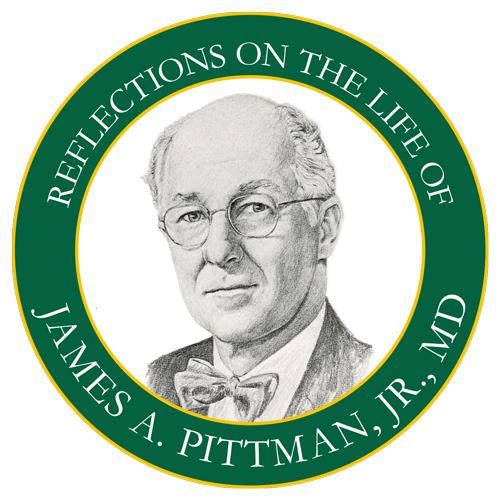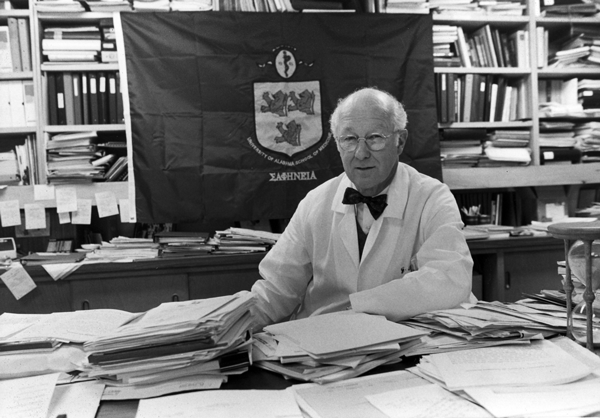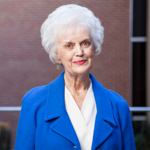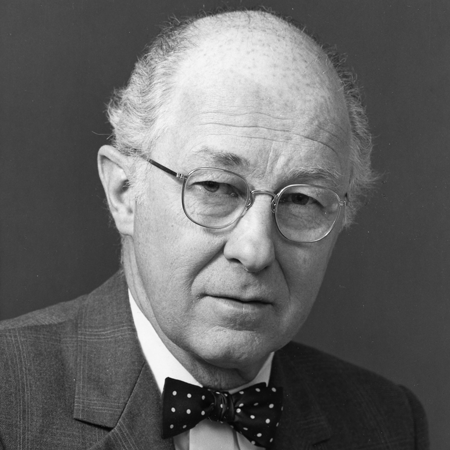 If I could pick the runner-up in the contest to select my favorite Dr. Pittman stories, it would be The Stretcher Story.
If I could pick the runner-up in the contest to select my favorite Dr. Pittman stories, it would be The Stretcher Story.
This took place in January 1982, during what would come to be known as Birmingham’s Great Winter Storm. That time will forever be embedded in my mind – not just because of the unexpected snow-and-ice storm that brought the Birmingham area to its knees for several days, but also because of something going on in my personal life at that time. On January 8, my husband Jim underwent open-heart surgery at UAB. It was his second time in six years to have that operation, and this one had been touch and go. He had survived, and, but the time this story begins, he actually was doing well, out of intensive care and in a private room in the core University Hospital building, which today we know as Jefferson Tower.
I had been off work for several days with Jim when January 12 rolled around – the day the storm hit. As I was about to leave home early that morning, to do to the office briefly and then to the hospital, I heard a TV weatherman saying that we needed to be on the alert for occasional sleet and freezing rain around sundown. Now, he wasn’t predicting a snow-and-ice storm, just a bit of sleet. But, since I lived on a mountaintop and certainly didn’t want to talk a chance on being separated from Jim by inclement weather, I quickly packed enough clothes and toiletries in case I decided to spend that night somewhere closer to the hospital.
Well, as it turned out, I would stay in Jim’s hospital room for three nights. A mixture of snow and ice (lots of it) started pounding the Birmingham area in late morning, just as I was arriving at UAB to visit Jim. Soon it had the city virtually shut down.
 In the meantime, as University Hospital began mobilizing to take care of business during this quite extensive storm, Dr. Jim Pittman was in his element. He was in one meeting after another as the hospital’s emergency plan went into effect. That plan included getting necessary hospital personnel brought in to work, making sure that physicians and nurses and others had safe transportation over increasingly treacherous roads. After Dr. Pittman left the meetings, he could be found making his rounds in the hospital’s hallways and rooms, checking to make sure that enough personnel indeed were available, especially in his area of physician coverage.
In the meantime, as University Hospital began mobilizing to take care of business during this quite extensive storm, Dr. Jim Pittman was in his element. He was in one meeting after another as the hospital’s emergency plan went into effect. That plan included getting necessary hospital personnel brought in to work, making sure that physicians and nurses and others had safe transportation over increasingly treacherous roads. After Dr. Pittman left the meetings, he could be found making his rounds in the hospital’s hallways and rooms, checking to make sure that enough personnel indeed were available, especially in his area of physician coverage.
That’s why Dr. Pittman entered the picture for me that day. He was trotting, almost sprinting, down a hospital hallway when he glanced inside my Jim’s room and spotted us. “Hey, You two!” he called out as he came in to check on us. He greeted my husband with, “Well, Jim, Dr. Karp (Dr. Robert Karp, Jim’s talented cardiac surgeon) tells me you beat the odds again and came through your surgery with flying colors.” Then, turning to me, he said, “Anita, you know you can’t get out of here. The snow and ice are sticking and poling up. You’re going to be staying here in this hospital room with Jim tonight, and maybe tomorrow night, too.” He continued to talk, non-stop, rapid-fire. “Where are you going to sleep in here? All you’ve got is that one straight-back chair. I’ll get you a cot. If I can’t find a cot – you know, we’re bringing in all the personnel we can find, and they’re grabbing the cots right and left for them to use – well, if I can’t get a cot, I’ll get you one of those durned broken-down reclining chairs that will make you want to get up from the chair and sleep standing up!” (He laughed. Like I said, Dr. Pittman was in his element participating in this emergency.) “I’ll be back!” He said. And he was off.
A couple of hours later, Dean Jim Pittman returned. He was wheeling in a dilapidated and BIG old heavy scratched-up metal stretcher/gurney contraption that looked like it had come over with Noah’s Ark. “No cots available. No reclining chairs,” he said. “But I found this, down in storage in the old Hillman Building.” (He referred to a hospital building adjacent to University Hospital that had been completed in 1903.) “Look at this thing! Isn’t she something!” he beamed proudly. “She has been around the block a few times – from the looks of her, been around a whole lot of years. When you finish with it, we might need to put it on display in a museum. But it will work better than you trying to sleep in that straight-back chair.” I thanked him, and my husband thanked him.
My Jim and I named the stretcher “Sally.” Don’t know why. But it seemed a good name. My dealings with this “Dr. Pittman stretcher” provided my husband with some entertainment that somewhat got his mind off his post-surgery discomfort – although he laughed a lot, and it hurt him to laugh. Jim had fun first of all watching me try to climb aboard Sally. (Man, that stretcher was high!) He had fun watching me try to control this relic. I failed; the stretcher’s ancient bent wheels had a mind of their own, and, whenever I moved the least but atop the stretcher, the wheels went into motion and the stretcher began to roll off with me aboard. And Jim had the most fun when I almost got evicted from the stretcher around 4 a.m. the next day. I though Dr. Pittman would never stop laughing when I told him about my near-eviction.
“Dr. Pittman, I was asleep on this stretcher you brought in,” I later recounted to him. “And this morning bright and early this nursing assistant with a bark like an Army sergeant awakened me and said I either had to get off the stretcher or I had to put on my long red coat that she had found hanging on Jim’s tiny closet. ‘Why do I have to put on my coat?’ I asked her. ‘I’m not cold.’ Her response to me was firm and to-the-point: ‘Child, it doesn’t have to do with whether you are cold or not. That nightgown you’ve got on is too close to the color of the hospital gowns some of our patients are wearing. With you lying on this gurney all decked out in that gown, well … with all the ruckus this storm is causing in this hospital, they might just wheel you down to surgery by mistake! But I don’t think they’re likely to wheel down some woman who’s wearing a long red coat.’”
Dr. Pittman thought that was the funniest thing. He joked to Jim, “Shoot! Anita might have missed a good deal on surgery. If she needs something fixed – anything that’s not working quite right – well, we’ve got all our very best surgeons in the house during this storm! Good time to have surgery. She would’ve just let them wheel her own down, gotten in line, and found herself a deal on a quick operation.”
 Anita Smith operates a Birmingham-based writing company, Anita Smith and Company, Inc. She specializes in writing about health and business and has written several nonfiction books about health-related institutions and distinguished health professionals. She has been named a Distinguished Alumna of what is now the University of Alabama College of Communication and Information Sciences. She is the first journalist inducted into the Alabama Healthcare Hall of Fame (2014).
Anita Smith operates a Birmingham-based writing company, Anita Smith and Company, Inc. She specializes in writing about health and business and has written several nonfiction books about health-related institutions and distinguished health professionals. She has been named a Distinguished Alumna of what is now the University of Alabama College of Communication and Information Sciences. She is the first journalist inducted into the Alabama Healthcare Hall of Fame (2014).